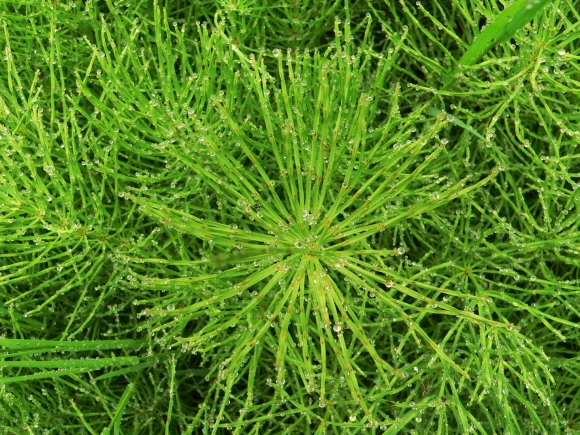 Horsetail (Equisetum arvense) grows everywhere in the five acres that transition from my house to protected wetlands. And it grows everywhere else; from the Mediterranian to here in Alaska, and further, I think.
Horsetail (Equisetum arvense) grows everywhere in the five acres that transition from my house to protected wetlands. And it grows everywhere else; from the Mediterranian to here in Alaska, and further, I think.
Horsetail species are an ancient plant with roots that can run hundreds of feet deep; they have not changed much over the last 100 million years, except they now grow perhaps 10 cm tall instead of the great heights of the dinosaur times. That their roots grow so deep may explain why they are able to absorb so many soil minerals like manganese, calcium, and iron. Horsetail is also high in flavonoids, caffeic acid esters, silica, saponins, tannins, alkaloids phytosterols, glycosides, and phenolic acids (Qureshi 2016).
But perhaps their greatest claim to fame is Horsetail’s silica content. Orthosilicic acid is the form of silica absorbed by humans and found throughout the body including bone, tendons, aorta, liver and kidney; probably essential for health no RDI has been established for silica (Martin 2007).
How to use Horsetail?
Healing Decoction in 50% alcohol: steeped for at least 6 weeks. Preferred for its healing properties.
Not that much time? Make a 15 minute steeped tea: Cover a cup of chopped horsetails from your backyard in a few cups water.
Here’s the basic recipe:
- Go cut about 6 stalks of horsetail.
- chop it into 1″ lengths or so (this is obviously not a precision recipe)
- Put chopped horsetail lengths into a 2 quart stock pot, cover with 1 quart (4 cups) of water, bring to a boil and simmer 15 minutes.
- Pour off the liquid tea and enjoy!
Some peer-reviewed medical literature states that horsetail tea is a gentle long term remedy for strengthening hair and nails and can support bone health (my initial interest since I managed a hairline knee fracture and then a wrist fracture last summer while competitively running at age 58).
It gets better… Other peer-reviewed literature explains how horsetail (equisetum) helps kidney function, circulation, and lymph drainage. Helps dissolve kidney stones, liver function, and gall bladder stones.
Tastes like the green grass of summer pastures, green tea, and grows all over the world. Fun!
References:
Martin, K.R. (2007) The chemistry of silica and its potential health benefits. The Journal of Nutrition, Health & Aging. 11(2):94-7.
Qureshi, M.N., Stecher, G., Bonn, G.K.(2016) Quantification of polyphenolic compounds and flavonoids in Achillea millefolium and Equisetum arvense. Pakistan Journal of Pharmaceutical Science, 29(5):1519-1523.
Copyright © 2017 Marie Sternquist. All Rights Reserved







